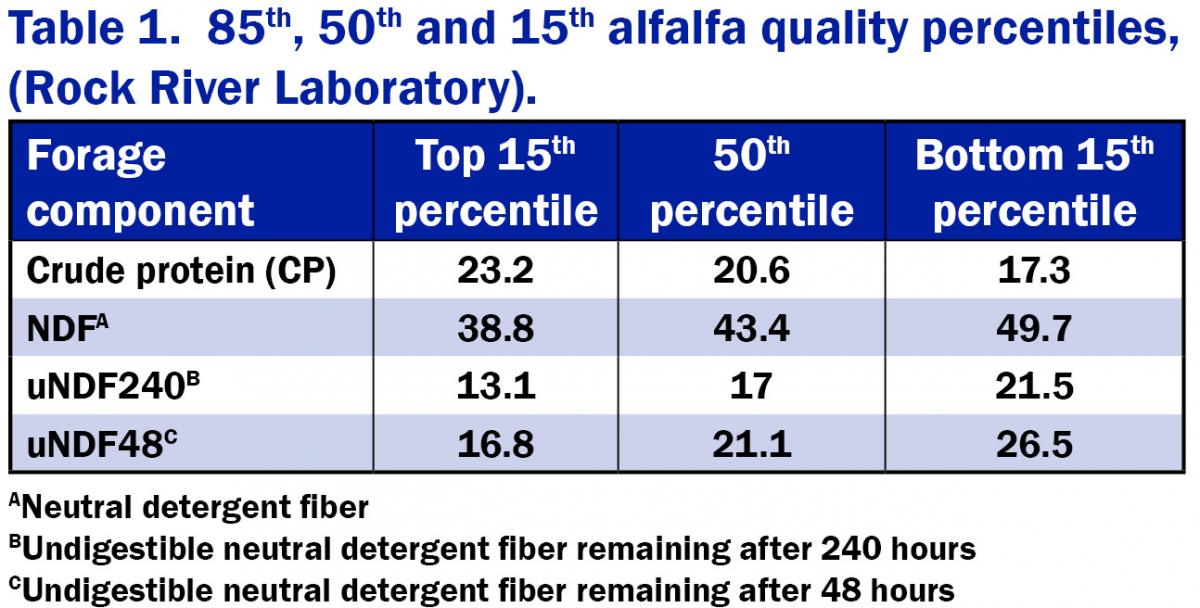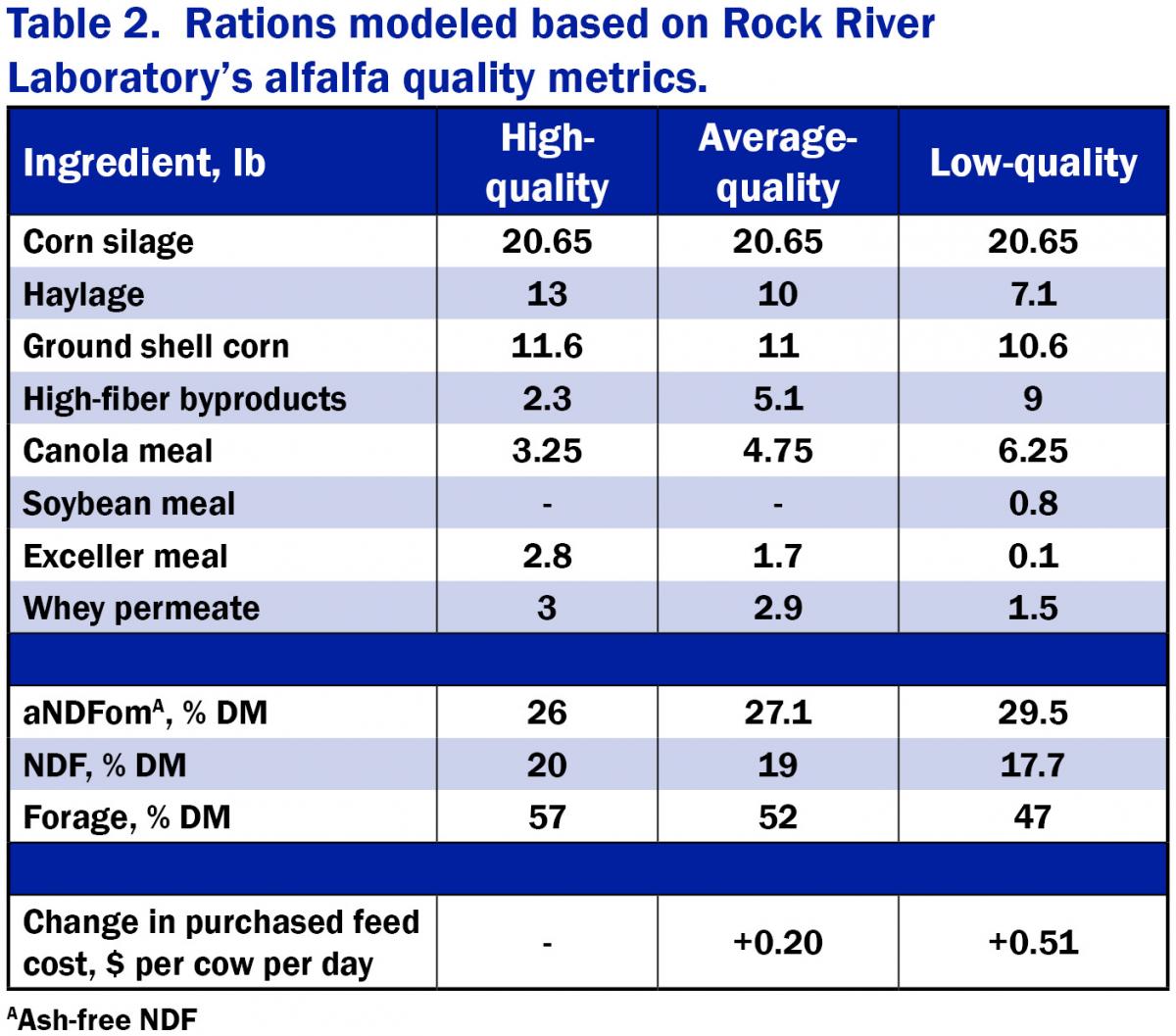
Alfalfa can calm the protein landscape

 By Nathan Hrnicek & Stacy Nichols
By Nathan Hrnicek & Stacy NicholsSoybean meal is currently priced well over $300 per ton, and, in the last five years, prices have been lower than $300 for only eight months, while it has been greater than $400 for fourteen months. Additionally, Argentina’s soybean crop is lower this year and the world demand for protein feeds continues to increase. Amid this, dairy producers are looking for opportunities to maintain margins. Growing and feeding more high-quality alfalfa can help improve dairy margins by decreasing purchased protein and byproduct costs.
Nicknamed “The Queen of Forages,” alfalfa quality is determined based on the protein content, fiber content and fiber digestibility. Table 1 shows Rock River Laboratory Inc.’s database values from 2016 to 2018 representing the 85th, 50th and 15th alfalfa quality percentiles.

How do you elevate your alfalfa management program into the top 15th percentile?
Growing high-quality alfalfa often depends on the management you put into the crop, along with the timing and process of harvest.
Ask yourself:
- Am I treating my alfalfa crop like an extremely valuable commodity?
- Do I plan a progressive management system, including variety selection, proper fertility, weed management, fungicide and insecticide usage, and pre-harvest scouting?
- Am I harvesting and storing the crop to minimize leaf and protein losses throughout the process?
If you don’t answer “yes” to all those questions, then you have room for improvement in your alfalfa crop management program. This can be quite an exhaustive list, but when we see producers consistently achieving alfalfa crops with more than 23 percent CP and higher digestible fiber, we know they are answering yes to most of those questions.
It all begins with pre-harvest scouting. Scout fields to see if a fungicide application is warranted. If you notice significant leaf loss during previous harvests, a fungicide will most likely help. Take a scissor clipping between days 18 and 21 to get an accurate CP level. You can estimate CP losses between 0.25 to 0.5 points per day while alfalfa is in the bud stage. Plan accordingly, get rid of the calendar, and harvest those plants when they tell you it’s time! To help avoid leaf loss, minimize the number of times alfalfa is handled and use roller conditioners and mergers. Finally, use a high-quality upfront fermenter to aid in a rapid pH drop during storage and to help prevent the breakdown of proteins.
With recent breakthroughs in the understanding of fiber digestibility, nutritionists have more confidence in the impact forage fiber quality has on cow performance. Rock River Laboratory’s data in Table 1 was used to model three different rations, based on alfalfa quality, in Table 2. The three rations were formulated to meet nutritional requirements of high-producing dairy cows using prices from July 2018 in southern Wisconsin. Corn silage makes up 35 percent of ration dry matter (DM) and dietary protein fractions and starch levels were held at equal values for all rations. Haylage was optimized into the rations based on quality. The final rations contained forage levels at 57, 52 and 47 percent.

Compared to rations with average- and low-quality haylage, the high-quality haylage ration decreased purchased feed costs per cow per day because it didn’t require additional protein or byproduct purchases. On the other hand, the average-quality and low-quality rations resulted in a 20-cent and 51-cent increase in purchased feed costs per cow per day. Depending on the available byproducts in your location, high-quality alfalfa could result in greater savings.
This comparison shows that managing alfalfa for high quality and having enough acres dedicated to feed higher levels in rations can help dairies hedge risk against high feed protein costs.
It is our goal to help dairy producers grow the highest quality forages possible, which in turn will make your operation more profitable. Utilizing proactive, intense management strategies can result in a tremendous high-quality, home-grown protein source. Take care of your alfalfa, and it will take care of you. Long live the Alfalfa Queen!
About the authors: Nathan Hrnicek is a Vita Plus forage products specialist, working closely with producers and Vita Plus and dealer staff in Michigan, Indiana, Illinois, and Ohio. He grew up on his family’s 1,200-acre diversified crop and livestock farm. He earned his associate’s degree in general agriculture from the Ivy Tech Community College in Lafayette, Indiana. He built his agronomy and forage expertise through several career experiences in seed sales as well as a sampling laboratory.
Stacy Nichols is a Vita Plus dairy technical specialist. He grew up in northwest Illinois and finished high school in northeast Georgia. He received his bachelor’s and master’s degrees in dairy science from the University of Georgia. Nichols was the herdsman at Mississippi State University’s Bearden Dairy Research Center from 1994 to 1996. He then returned to Georgia as the herdsman on a private 350-cow dairy. Since 1997, he has been involved in the dairy feed industry on a local, national and global level. Nichols has considerable experience in transition cow management, nutritional modeling and amino acid formulation. He and his wife, Melissa, have eight children and reside in northwest Indiana.
| Category: |
Dairy Performance Feed quality and nutrition Forage harvesting |

